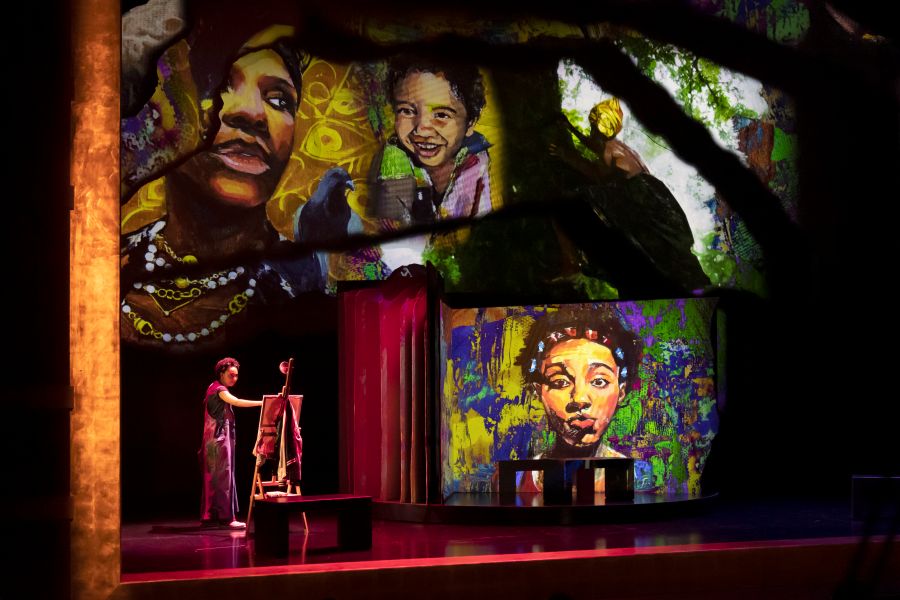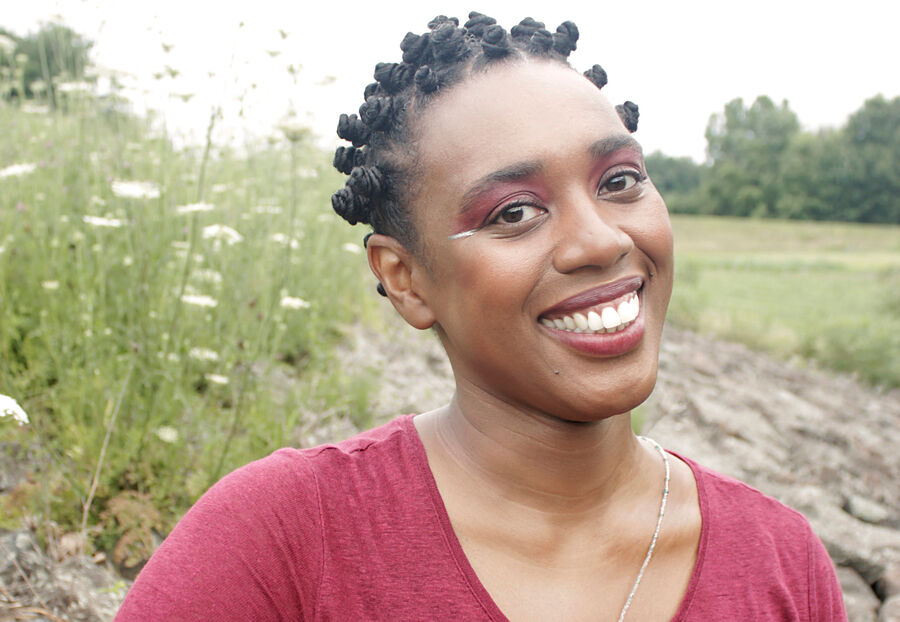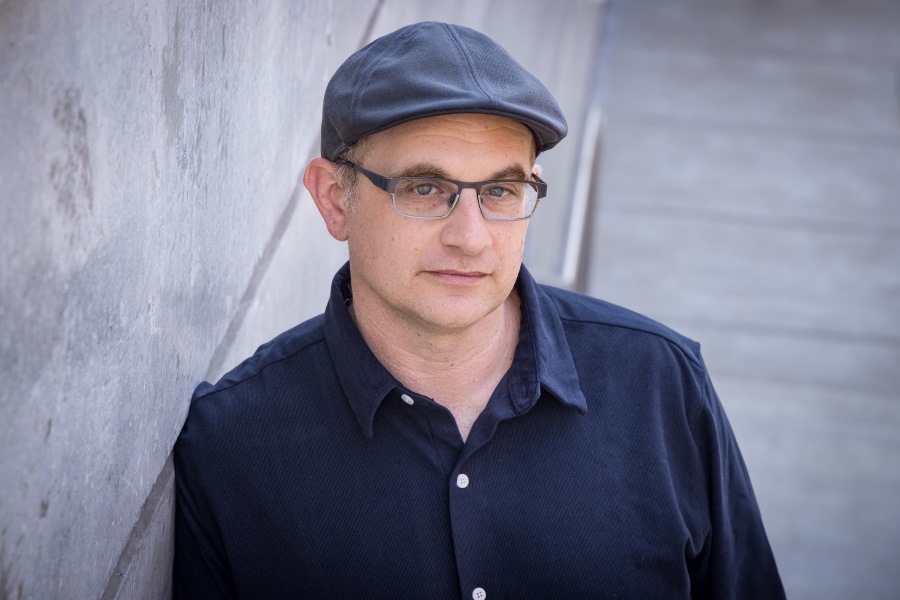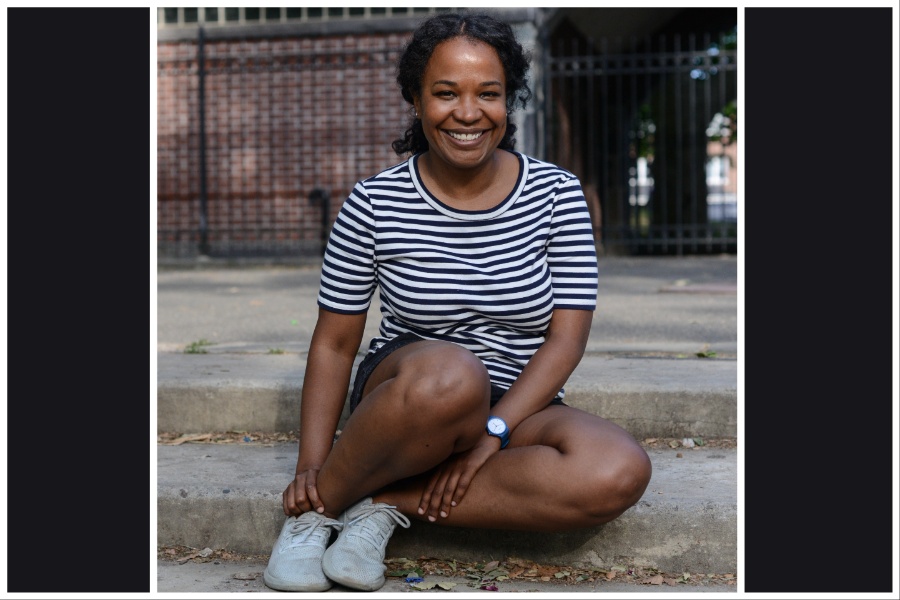Lenelle Moïse’s K-I-S-S-I-N-G (the complete playscript of which appears in our Spring 2025 issue) follows a young painter, Lala, in her relationships with Dani, a romantic aesthete, and his brother Albert, a passionate dancer, and with her parents, Jack and Dot. Moïse talked with actor April Matthis (Toni Stone, Primary Trust) about the play’s inspirations and resonances.
APRIL MATTHIS: I read this play for the Blackburn Prize, and just fell in love with these characters. Then I watched the production at the Huntington and fell in love all over again. It feels like what you wrote on the page got translated. It’s hard for all kinds of reasons for playwrights to get the thing that they imagined onto the stage. But when I saw the art, the drawings but also the references to Klimt, the Orientalists, Jean-Léon Gérôme—and is Magritte in there?—I was like, “This is amazing.”
LENELLE MOÏSE: I’m very much a museum geek, and in any city that I visit, one of the first things I want to do is go see what the local collection is and just be with the work. Those are my favorite dates, and also just my favorite ways to be with friends and acquaintances. I just love walking into a space that’s dedicated and devoted to art. I’m always interested in that interplay between pop and art, which I think is what we do in the theatre: We want to make it feel accessible and fun, but it also has to do all the things that Magritte does, which is freak us out and make us feel stuff.
I love that. A museum is the first date for these teens, Lala and Dani. I’m curious, what was your interest in a teen love story?
I started working on this play while I was visiting Boston again as an adult. I grew up in Cambridge, just across the Charles River. Being back home meant revisiting the sites that meant a lot to me as a young person: specific parks, cafés, and museums.
Also, at the time, Black Lives Matter became a chant. It became a thing that we were all learning and saying and writing and riffing off of. It was so clearly a cultural and activist response to violence against young Black people. And I found myself thinking about my own youth. The play came out of wanting to counterpoint images of violence with images of creativity—to show Black characters expressing their subjectivity, freedom, range of movement, and feelings. I thought, what would happen if, in the safer space of a theatre, we could imagine Black teenagers holistically?
I have to tell this story: I was in Austin, Texas, taking a bus to somewhere. And in the back, I saw this young Black man, maybe 19 or 20, wearing a hoodie and looking really intense and anxious. Then he pulled out a little black velvet box and opened it. He looked at the ring inside and closed the box, and he put it back in his pocket. He was fidgeting and fidgeting, looking really nervous. Then he looked at the engagement ring again. I was like, if only everyone could see what I see happening for this brother in the back of the bus—a young man on his way to his next level. If only we could see him in his black hoodie and imagine his heart, his longing, his hopes. I just wanted to find my way into a story that could be his.
Oh my gosh, that’s so beautiful. That’s what grabbed me about this piece: just how beautiful and tender it is, how tenderly you care for these teens. I didn’t feel this specter of racist worry for them. It’s not a race-neutral world where that doesn’t exist, but we get to see everything else that they think about, which is most of life. This is something I see so rarely. As long as I’ve been around in the theatre space, but also in film and television, it still feels like, when Black folks are present, there’s this expectation of, how are we going to show the fear, the horror, the injustice? And if we don’t, somehow we’re giving short shrift to that reality. What’s so refreshing is that it’s not like you’re not aware of that, but the question is, what are we trying to protect? We say Black Lives Matter, but what does the mattering look like?
I love that. Also the “lives” part: to live, to really feel alive. That’s why I wrote about love. Love makes me feel alive. You know, if you flip the word revolution backwards, you’ll find the word love at the core of it. I spend a lot of time reflecting on that: the love that’s secretly embedded in revolution. Love is presence and curiosity. It’s what you don’t know but you need to find out.

What particularly hit my ear was how your characters sound like teenagers, in their enthusiasm and in the way they’re able to comment on themselves in real time and comment on their behavior in real time—these sound like real teen people that I’ve heard. Are you around teen folks?
One cool thing about the process of writing K-I-S-S-I-N-G is that I knew I needed to be around younger people. So I did a couple of college-based developmental workshops. Clark University commissioned an early version of this piece with way more characters—11! Back then, it was an ensemble piece about teen angst. But then Valentine’s Day rolled around, so the play got more romantic. Being around people who were 18, 19, 20, I got to listen to their slang. I watched the way they razzed each other and jazzed each other.
Years later, with a different group of acting students, I asked, “Wait, have any of you ever been in love?” And they were like, “Nah. We’re on the apps. We hook up.” I was blown away by that. I really could feel my age! I grew up in a time when courting was about making a mixtape for your beloved or your crush, writing your own liner notes, with stickers and little collages, and offering that effort to someone. Everything was just slower. I wanted to offer that, as an auntie, to say, “Hey, do you know that you can slow it down a little bit and see what it tastes like?”
I wanted to ask about the parents, Jack and Dot. They conceive a child when she’s 16, and it happens in a stairwell. I’m really interested in what you were thinking about with the contrast between the parents’ relationship, which doesn’t work out, and the young people’s relationship—how they’re able to be themselves and just feel their feelings. For the parents, the stakes were different.
Jack and Dot don’t have much privacy. They have to borrow transitional spaces to explore their intimacy. Jack talks about their after-school walks getting longer and longer. That’s because they don’t have a room to be alone in! And since their private time is limited, they skip steps, they rush in.
Like her parents, Lala has to grow up fast; she’s got a lot of responsibilities at home. But there’s something about her being an artist⏤a girl who walks around with her sketchbook. She gets to create a private space for herself, an internal world. When Lala hears her father talk about how he asked her mama out, she wants that quality of intimacy for herself. And then, like magic, she meets a boy who likes the same song Jack likes!
Lala and Dani have a unique dynamic. It’s spiritual and intellectual. They have so much chemistry, but they don’t make out. It’s romantic and intentional and analog. Like writing a letter! When I first met my wife, we hand-wrote letters to each other every two days. I remember that feeling of running to the mailbox to receive something that her hands had touched⏤that my hands were now touching—it felt so thrilling, so necessary, so vital.
I also think a lot about how Lala can’t draw hands and faces at the top of the show because her mother doesn’t really let Lala look at her very long, and they probably don’t hug. Only through the relationship with Dani—and later Albert—does Lala get the opportunity to look at lips and eyes and hands, to actually study these things. It’s good for her art! Close-ups of the boy who touches trees and has calluses and is really seeing her. And then the boy who is such a beautiful dancer and has passion in his eyes.
I want to get into the queerness in this story, which feels very contemporary: having the language around this particular type of queerness—asexuality—explored for the first time I’ve seen it with young Black people in a play. I think about bell hooks’s definition of queerness as being outside the paradigm of what norms are. I was trying to observe the paradigms in the production with those wonderful actors, Regan Sims and Sharmarke Yusuf: Like, okay, legs are on top of legs, hands are being held, but a kiss is a bridge beyond comfort. I just loved how these experiences and feelings get explored with kindness and grace.
I am so lucky that those actors did the professional world premiere, because they just loved the text so much. I consider myself very much an actor’s writer. So it’s just a gift for me when the poetry of the dialogue is spoken and held.
As for the queerness piece—since I’ve been out, LGBTQIA is always in the air, and I realized at some point that the A part of that gets little air time, so I wanted to expand my own understanding of my community. One of my favorite behind-the-scenes moments at the Huntington was having folks from the asexual community come in and consult with the cast and creative team. We met a middle-aged husband and dad who identifies as asexual and romantic. He shared so beautifully with us that his understanding of his asexuality doesn’t erase feelings of jealousy or attachment or the desire to be close. If anything, courting and wooing feels more expansive.
Personally, it drives me bananas that love scenes are usually sex scenes. I think of K-I-S-S-I-N-G as an offering to get us to think differently about what a love scene can look like. Fraternal love, romantic love, the love between parent and child, love of the arts—all of it needs to be explored on a spectrum.
When I started writing the script, I noticed Dani dodging Lala’s kisses. So I just asked the character, as I do, “Why aren’t you kissing this girl? What is going on?” And he told me he was an ace. What I love about Dani is that he is a kid of our time, who can look stuff up online. In his search, he finds a word for the experience he’s having. As the play goes on, his self-definition gets more precise.

I want to come back to the mother. I’m just so curious, especially given all you’ve said before about how expansive you want love to be, who she is for you. We get so many different facets of her. Our first image of her is when she’s 16 and she lets the baby go; she seems very troubled. And then she’s embodied on the stage as this beautiful actress who is dressed very well.
I’m reminded that one of the themes of the play is what we inherit from our parents—not just the heirlooms or the finances but the emotional gifts and the emotional baggage. Lala is more open to Dani because she has experienced her father enjoying the song “Young Americans,” and Lala is tough with Albert when they first meet because she has inherited her mother’s toughness. We’re watching kids who are their own people, but they also still have some stuff they’re carrying.
We meet Dot in crisis. She’s searching for connection, but so traumatized, it’s hard for her to accomplish the kind of mothering she can see her daughter needs—her need to not feel shame, her need to not be hindered by her environment. Dot’s act of love is to release her daughter. Sometimes you gotta love from afar. In the script, it says something to the effect of, “Dot looks like a woman you’d want to paint.” I think a lot about what it means for Lala, the artist, to be looking at her mother and wanting to paint her.
Support American Theatre: a just and thriving theatre ecology begins with information for all. Please join us in this mission by joining TCG, which entitles you to copies of our quarterly print magazine and helps support a long legacy of quality nonprofit arts journalism.





